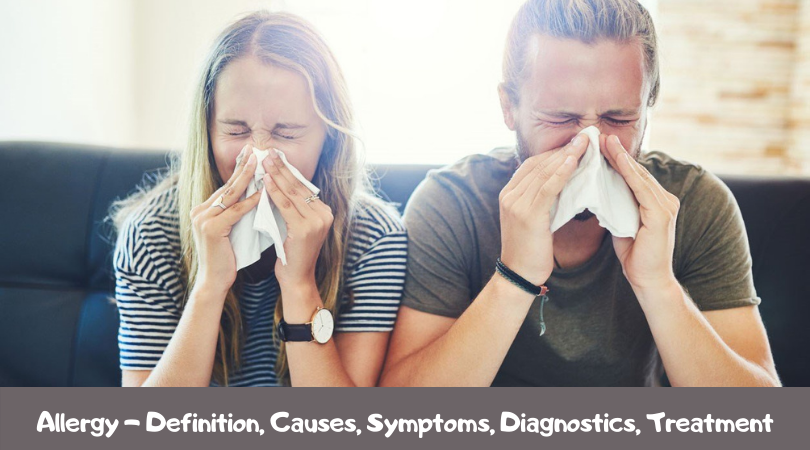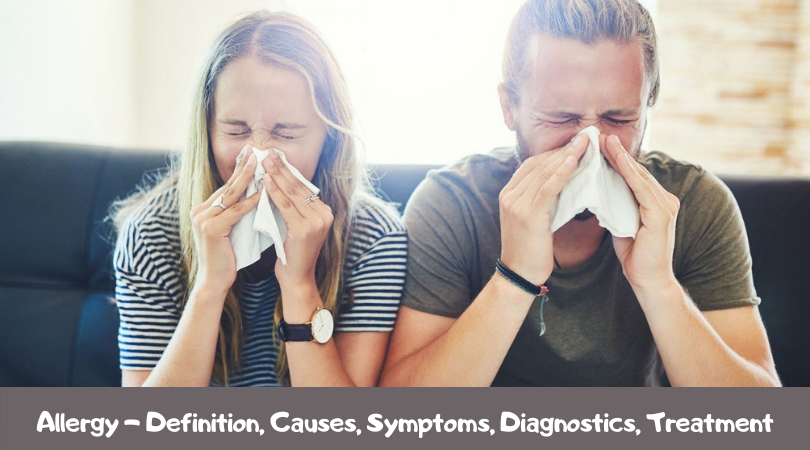Allergy – Definition, Causes, Symptoms, Diagnostics, Treatment
 Allergy is a body condition in which the immune system sees a threat in substances that are not actually dangerous to humans. The immune system considers them to be antigens, so it begins to develop antibodies against them. During this period, a person begins to feel that the body is fighting the disease, which is manifested by unpleasant symptoms.
Allergy is a body condition in which the immune system sees a threat in substances that are not actually dangerous to humans. The immune system considers them to be antigens, so it begins to develop antibodies against them. During this period, a person begins to feel that the body is fighting the disease, which is manifested by unpleasant symptoms.
In fact, there are no real pathogens. This increased sensitivity of the body to certain substances (allergens) is called allergy.
Symptoms and signs
An allergic reaction can be of different intensity – from mild to acute. Moreover, depending on the allergen, a person may manifest different symptoms. The main symptoms are:
- allergy to animals. It is easy to diagnose it when, eyes turn red and tears flow, a runny nose or dry cough begin upon contact with pets;
- allergies to cats and dogs can also cause redness and itching of the skin;
- food allergy. It causes redness and induration of the skin, accompanied by itching. Sometimes conjunctivitis or runny nose appears. Allergy to the skin manifests itself in the form of dermatitis. Inhalation of vapors or particles of allergens affects the respiratory system;
- allergy to blooming. Pollen causes allergic rhinitis, conjunctivitis, wheezing and dry cough, itching of the tongue and palate;
- allergy to medications. It may manifest as urticaria, attacks of bronchial asthma, allergic dermatitis, Quincke’s edema. Allergy spots increase over time. From small ones, they can merge into large ones.
Similar symptoms can occur with allergies to protein, cold or dust, and insect bites.
Causes and risk factors
Modern medicine does not give the exact causes of allergies in adults and children. The main role in the mechanism of its occurrence is assigned to genetics. If one of the parents has it, then the child will have it with a 30% probability, if both – 70%. Severe allergies during pregnancy can develop due to a decrease in immunity.
Doctors only underline risk factors that trigger the pathological process. Such factors include:
- unbalanced diet;
- severe stress;
- excessive use of medications;
- unfavorable ecology;
- frequent respiratory tract infections: tonsillitis, bronchitis, rhinitis;
- the presence of large quantities of household allergens;
- artificial feeding, including premature transfer to it.
By addressing risk factors, the risk of allergic reactions can be reduced.
Complications
In children and adults, allergy symptoms can provoke multiple complications. Among them, the most dangerous are:
- anaphylactic shock;
- acute vascular insufficiency;
- convulsions;
- nausea and dizziness;
- Quincke’s edema.
In severe cases, anaphylactic shock and Quincke’s edema can be fatal. With atopic dermatitis against the background of skin allergies, other skin diseases are often associated, including mycosis and herpes.
When symptoms manifest as eye disorder, corneal hypertrophy may develop due to frequent rubbing. It limits a person’s vision. About half of children who suffered from skin allergies in childhood may develop bronchial asthma in adulthood.
Preparing for a doctor’s visit
At the appointment, the allergist asks the patient about the existing symptoms and what preceded their appearance. Therefore, when preparing for an appointment, it is necessary to think over and even write down what signs appear and in what situations.
This will allow the doctor to guess the type of allergen that is causing the negative reaction. Even at the reception, the allergist will examine the skin, so it is better to wear clothes with which it will be easy to provide access to the foci of inflammation on the skin.
Diagnosis of allergies in adults and children
First of all, the doctor pays attention to diagnostic signs of allergy on the face and other areas, as well as mucous membranes. Subjective complaints of the patient are also taken into account. To confirm the diagnosis, the doctor appoints the following tests:
- allergen analysis. Also called breakdown, it plays an important role in diagnosis. The tests are carried out at the stage of remission. To do this, a drop of a solution with a small allergen amount is applied to the skin, after which the reaction is monitored;
- blood test for allergies. There are also changes in the blood: an increase in eosinophils, immunoglobulins E;
- analysis for specific antibodies, for example, to a parasitic disease, infection or dust.
Treatment of allergies
The main method of treating allergies is adherence to a special diet. This is what allows you to get rid of unpleasant symptoms and minimize the risk of relapse. The diet for allergies is followed for life, since this disease is chronic. It requires a complete exclusion from the diet of those foods that provoke the appearance of its symptoms. There are 2 types of diet:
- specific. It is prescribed for patients who have been identified by laboratory allergens, for example, milk, eggs, protein, chocolate, etc. – here the diet will be individual for each person;
- nonspecific. Found when no specific allergen has been identified. Since no symptom provocateur has been identified, all potential food allergy provocateurs should be excluded from the diet.
On a non-specific diet, the patient is additionally recommended to keep a food diary. In it, it is necessary to record the food consumed and the reaction that occurs to it on a daily basis. In this way, the patient will gradually be able to identify food allergens on their own.
Additionally, other methods of treatment are practiced today:
- intravenous laser blood irradiation. It provides immuno-strengthening and anti-inflammatory effects;
- allergen-specific immunotherapy. An allergen is introduced into the body, the dose of which is gradually increased in order to reduce the body’s sensitivity to it.


